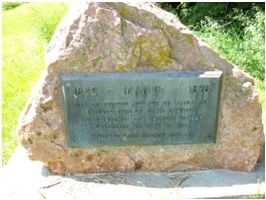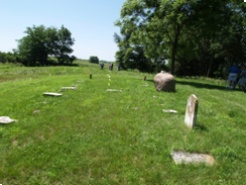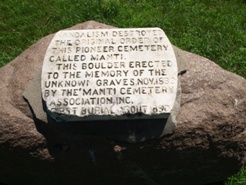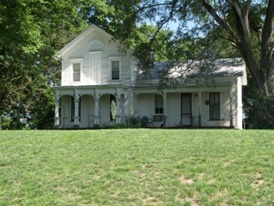Fisher’s Grove is located in southwestern Iowa and is three to five miles southwest of the town of Shenandoah and approximately 50 miles southeast of Council Bluffs.
During the initial stages of settling Fisher’s Grove walnut trees covered the area and rivers and creeks like Fisher Creek, Walnut Creek, and the Nishnabotna River
bordered the area, providing adequate water resources for the settlers. The earliest white settlers in the area came around 1846 and made small, temporary settlements.
With the arrival of Edmund Fisher in 1852, permanent settlements formed by acquiring lands from “a pioneer named Haddon (1).”
 Thereafter the town derived its name from
Edmund Fisher and settlers began to migrate from Mills County to develop the area. The new settlement's distance from the LDS headquarters in Iowa provided the majority
of the population, disaffected “Mormons,” adequate space to adhere to their beliefs with the “True Church of Jesus Christ of Latter Day Saints” under their leader Alpheus Cutler.
Within a few years of Fisher’s arrival, the settlement grew to “thirty or forty families (2)” and the settlement’s name changed to Manti after “a city and province found in the Book of Mormon (3).”
According to Lew Weigand “at one time there was probably five-hundred Cutlerites (members of the True Church of Jesus Christ of Latter Day Saints)” in the area.**
Thereafter the town derived its name from
Edmund Fisher and settlers began to migrate from Mills County to develop the area. The new settlement's distance from the LDS headquarters in Iowa provided the majority
of the population, disaffected “Mormons,” adequate space to adhere to their beliefs with the “True Church of Jesus Christ of Latter Day Saints” under their leader Alpheus Cutler.
Within a few years of Fisher’s arrival, the settlement grew to “thirty or forty families (2)” and the settlement’s name changed to Manti after “a city and province found in the Book of Mormon (3).”
According to Lew Weigand “at one time there was probably five-hundred Cutlerites (members of the True Church of Jesus Christ of Latter Day Saints)” in the area.**
Reasons for Edmund Fisher settling in the area of the Shenandoah Valley are unexplained but Alpheus Cutler and the Cutlerites relocated to the area in hopes of further
disassociating themselves from The Church of Jesus Christ of Latter-Day Saints and its President, Brigham Young. Alpheus Cutler and his band of believers separated from
Brigham Young and the majority of the Church due to polygamy while still adhering to all other LDS practices. Another possible dividing factor, according to Lew Weigand,
is that Alpheus Cutler had a “different vision of what the Church ought to be doing.” “His idea was to go south and send missionaries to the Indians living in Kansas.
Cutler also believed he would eventually “drive the Missourians out of Independence and take over.”** Those who believed in this vision began to file into the area from
1853-1856 and included “Alpheus Cutler, Sr., Thaddeus Cutler, Chauncey Almond, Amos Cox, Edmond Whiting, Caleb Baldwin, Nicholas Taylor, E. C. Whiting, Calvin and Edward
Fletcher and their father, Luman H. Calkins, Squire Eggleston, William Steele, Clark Stillman and Frank Pratt (4).”
 Other settlers gradually came into the area and helped to develop the area into a town with the necessary amenities of life like a mill, church, school, blacksmith shop,
farms, mail lines, and even a hotel. In 1853 “the first schoolhouse…was erected and used until 1869” and was later used as a blacksmith shop. Just “southeast of the
schoolhouse” the town formed the Manti Cemetery, which is marked with some type of stone/bronze tablet. Later, Alpheus Cutler assisted in the building of a church in
1854 and there the practices of the Cutlerites began which initiated their formal separation from the “Brighamites (5)”. The Travelers Inn Hotel also began operation in
1856 and even held a “place to keep stage route horses” and carriages under the direction of William C. Matthews. Various stores and shops eventually serviced the town
and provided the it with the various odds-and-ends needed for everyday life in the frontier.
Other settlers gradually came into the area and helped to develop the area into a town with the necessary amenities of life like a mill, church, school, blacksmith shop,
farms, mail lines, and even a hotel. In 1853 “the first schoolhouse…was erected and used until 1869” and was later used as a blacksmith shop. Just “southeast of the
schoolhouse” the town formed the Manti Cemetery, which is marked with some type of stone/bronze tablet. Later, Alpheus Cutler assisted in the building of a church in
1854 and there the practices of the Cutlerites began which initiated their formal separation from the “Brighamites (5)”. The Travelers Inn Hotel also began operation in
1856 and even held a “place to keep stage route horses” and carriages under the direction of William C. Matthews. Various stores and shops eventually serviced the town
and provided the it with the various odds-and-ends needed for everyday life in the frontier.
 Under the direction of Alpheus Cutler, several settlers served missions to the American Indians in Grasshopper, Kansas and “endeavored to set up a settlement among the
Indians.” The missionaries enjoyed meager success and eventually abandoned the mission to return to Manti (6). Reasons for the fervent missionary work amongst the
American Indians relates to the call Alpheus believes he received from Joseph Smith Jr. prior to his June 1844 martyrdom. Alpheus felt he “had a mandate from Joseph
Smith to preach the gospel to the Indians (7).” Due to this undeterred belief, Alpheus refused to come west to Salt Lake City at the request of Brigham Young and the
Quorum of the Twelve Apostles. For this, he was excommunicated from The Church of Jesus Christ of Latter-Day Saints on April 20, 1851. After this, many of the Silver
Creek Branch members, the LDS branch Cutler presided over at the time, “became followers of Cutler” forming the True Church of Jesus Christ of Latter Day Saints and
helped to settle Manti (8).
Under the direction of Alpheus Cutler, several settlers served missions to the American Indians in Grasshopper, Kansas and “endeavored to set up a settlement among the
Indians.” The missionaries enjoyed meager success and eventually abandoned the mission to return to Manti (6). Reasons for the fervent missionary work amongst the
American Indians relates to the call Alpheus believes he received from Joseph Smith Jr. prior to his June 1844 martyrdom. Alpheus felt he “had a mandate from Joseph
Smith to preach the gospel to the Indians (7).” Due to this undeterred belief, Alpheus refused to come west to Salt Lake City at the request of Brigham Young and the
Quorum of the Twelve Apostles. For this, he was excommunicated from The Church of Jesus Christ of Latter-Day Saints on April 20, 1851. After this, many of the Silver
Creek Branch members, the LDS branch Cutler presided over at the time, “became followers of Cutler” forming the True Church of Jesus Christ of Latter Day Saints and
helped to settle Manti (8).
 Cutler and his followers refused to follow the practice of polygamy and trek west, thus, the Cutlerite religion formed. The refusal to adhere to polygamy became problematic
for Alpheus and his family since he was a polygamist and had seven wives himself. As a member of the Council of Fifty and with the permission of his first wife,
Lois Cutler (maiden name: Lois Huntington Lathrop) he engaged in the practice of polygamy. On January 14, 1846 he was sealed to Lois and “Luana Hart Beebe on the
same day. On 3 February 1846 he was sealed to five more wives in temple ceremonies: Margaret Carr, and her sister, Abigail, Sally Cox, Daisey Caroline McCall,
and Henrietta Clarinda Miller (9).” Since the Cutlerites refused the practice of polygamy and Mills County, Alpheus Cutler’s home in 1851, outlawed the practice,
Alpheus “renounced his plural marriages (10).”
Cutler and his followers refused to follow the practice of polygamy and trek west, thus, the Cutlerite religion formed. The refusal to adhere to polygamy became problematic
for Alpheus and his family since he was a polygamist and had seven wives himself. As a member of the Council of Fifty and with the permission of his first wife,
Lois Cutler (maiden name: Lois Huntington Lathrop) he engaged in the practice of polygamy. On January 14, 1846 he was sealed to Lois and “Luana Hart Beebe on the
same day. On 3 February 1846 he was sealed to five more wives in temple ceremonies: Margaret Carr, and her sister, Abigail, Sally Cox, Daisey Caroline McCall,
and Henrietta Clarinda Miller (9).” Since the Cutlerites refused the practice of polygamy and Mills County, Alpheus Cutler’s home in 1851, outlawed the practice,
Alpheus “renounced his plural marriages (10).”
The history regarding these individuals after they separated from Alpheus is unknown excepting Luana Hart Beebe and Sally Cox. Luana “remained with the Cutlerites”
for a time before leaving “to Utah” where she died “in 1897.” “Luana had three children while married to Alpheus, Jacob Lorenzo (1846), Olive Luana (1850), and
Lydia Ann (unknown). The paternity of these children was kept secret and other surnames were used for the children (11).”
Sally Cox also traveled to Utah and trekked with the “Ezra Taft Benson Company.” Records also indicate that she “died in Salt Lake City in 1863 (12).”
Concerning Alpheus Cutler’s own children, two of them “went west with the main body of the church.” William Lathrop Cutler and Louisa Elizabetha Cutler Rappleye
lived and died in Utah with their respective families. Two of his other children, Clarissa and Emily, married Heber Chase Kimball, a member of the Quorum of
the Twelve Apostles, but upon his trek westward to Utah they remained with their father and “married Cutlerite men (13).” Before these two separated from their
husband Heber they each had a son, Abraham and Isaac Kimball. Early on they both lived in the home of Alpheus but “reunited with their father in Utah during
their early teens (14).”
 Manti flourished up to the mid-1860s but upon the death of Alpheus Cutler, the future of the town became compromised. “Father Cutler (15),” as followers named
him, died June 10, 1864 but prior to his passing he told his followers “of a land far to the north between two beautiful lakes, where they were to take a colony
and preach to the Indians.” Within a year’s time the Cutlerites discovered the prophesied land and “the whole colony removed there and founded the village of
Clitherall, Minnesota (16).” With this dramatic drop in population and the railroad bypassing the town, Manti soon diminished to cornfields by 1877 (17).
Manti flourished up to the mid-1860s but upon the death of Alpheus Cutler, the future of the town became compromised. “Father Cutler (15),” as followers named
him, died June 10, 1864 but prior to his passing he told his followers “of a land far to the north between two beautiful lakes, where they were to take a colony
and preach to the Indians.” Within a year’s time the Cutlerites discovered the prophesied land and “the whole colony removed there and founded the village of
Clitherall, Minnesota (16).” With this dramatic drop in population and the railroad bypassing the town, Manti soon diminished to cornfields by 1877 (17).
Shenandoah, a town founded in 1870 just five miles from Manti received the railroad and rose to prominence while Manti diminished.
Today Shenandoah remains a town while Manti has a small park monument southeast of the town dedicated to the early settlers of the area.
Sources: Used with permission of Brigham Young University and the 'Winter Quarters Project'
* A special thanks to Terry Latey for the photographs and the citizens of Shenandoah and other
surrounding towns for their support in the research of the settlement of Manti.
**Quotes from Lew Weigand were gathered on June 25, 2009 at the Manti Cemetery in Manti, Iowa.
Bibliography:
1) Kershaw, W. L. History of Page County, Iowa (Chicago: S. J. Publishing Co., 1909), 379.
2) Kershaw, W. L. History of Page County, Iowa (Chicago: S. J. Publishing Co., 1909), 379.
3) Wilcox, Pearl. Roots of the Reorganized Latter Day Saints in Southern Iowa (Independence, Missouri: P. G. Wilcox, 1989), 210.
4) Kershaw, W. L. History of Page County, Iowa (Chicago: S. J. Publishing Co., 1909), 380.
5) Kershaw, W. L. History of Page County, Iowa (Chicago: S. J. Publishing Co., 1909), 380-381; and Wilcox, Pearl. Roots of the Reorganized Latter Day Saints in Southern Iowa (Independence, Missouri: P. G. Wilcox, 1989), 211.
6) Wilcox, Pearl. Roots of the Reorganized Latter Day Saints in Southern Iowa (Independence, Missouri: P. G. Wilcox, 1989), 212.
7) Johnson, G. Vaughn. Alpheus Cutler: Temple Builder, Founder of Cutler’s Park, Schismatic (http://memeber.cax.net/pioneerheritage/feb2006p.pdf), 3.
8) ibid.
9) Johnson, G. Vaughn. Alpheus Cutler: Temple Builder, Founder of Cutler’s Park, Schismatic (http://memeber.cax.net/pioneerheritage/feb2006p.pdf), 3; also found in Jorgenson, Danny L.“The Old Fox: Alpheus Cutler”, Differing Visions: Dissenters in Mormon History. Roger D. Launius and Linda Thatcher, eds., (Urbana: University of Illinois Press), 162.
10) ibid.
11) ibid.
12) Johnson, G. Vaughn, 3.
13) ibid, 2.
14) ibid; also found in Jorgenson, Danny L.“The Old Fox: Alpheus Cutler”, 162.
15) Wilcox, Pearl. Roots of the Reorganized Latter Day Saints in Southern Iowa (Independence, Missouri: P. G. Wilcox, 1989), 212.
16) Davis, Inez Smith. The Story of the Church (http://www.centerplace.org/history/misc/soc/soc137.htm); also found in Johnson, G. Vaughn. Alpheus Cutler: Temple Builder, Founder of Cutler’s Park, Schismatic (http://memeber.cax.net/pioneerheritage/feb2006p.pdf), 3.
17) Wilcox, Pearl. Roots of the Reorganized Latter Day Saints in Southern Iowa (Independence, Missouri: P. G. Wilcox, 1989), 216-217.


 Thereafter the town derived its name from
Edmund Fisher and settlers began to migrate from Mills County to develop the area. The new settlement's distance from the LDS headquarters in Iowa provided the majority
of the population, disaffected “Mormons,” adequate space to adhere to their beliefs with the “True Church of Jesus Christ of Latter Day Saints” under their leader Alpheus Cutler.
Within a few years of Fisher’s arrival, the settlement grew to “thirty or forty families (2)” and the settlement’s name changed to Manti after “a city and province found in the Book of Mormon (3).”
According to Lew Weigand “at one time there was probably five-hundred Cutlerites (members of the True Church of Jesus Christ of Latter Day Saints)” in the area.**
Thereafter the town derived its name from
Edmund Fisher and settlers began to migrate from Mills County to develop the area. The new settlement's distance from the LDS headquarters in Iowa provided the majority
of the population, disaffected “Mormons,” adequate space to adhere to their beliefs with the “True Church of Jesus Christ of Latter Day Saints” under their leader Alpheus Cutler.
Within a few years of Fisher’s arrival, the settlement grew to “thirty or forty families (2)” and the settlement’s name changed to Manti after “a city and province found in the Book of Mormon (3).”
According to Lew Weigand “at one time there was probably five-hundred Cutlerites (members of the True Church of Jesus Christ of Latter Day Saints)” in the area.**  Other settlers gradually came into the area and helped to develop the area into a town with the necessary amenities of life like a mill, church, school, blacksmith shop,
farms, mail lines, and even a hotel. In 1853 “the first schoolhouse…was erected and used until 1869” and was later used as a blacksmith shop. Just “southeast of the
schoolhouse” the town formed the Manti Cemetery, which is marked with some type of stone/bronze tablet. Later, Alpheus Cutler assisted in the building of a church in
1854 and there the practices of the Cutlerites began which initiated their formal separation from the “Brighamites (5)”. The Travelers Inn Hotel also began operation in
1856 and even held a “place to keep stage route horses” and carriages under the direction of William C. Matthews. Various stores and shops eventually serviced the town
and provided the it with the various odds-and-ends needed for everyday life in the frontier.
Other settlers gradually came into the area and helped to develop the area into a town with the necessary amenities of life like a mill, church, school, blacksmith shop,
farms, mail lines, and even a hotel. In 1853 “the first schoolhouse…was erected and used until 1869” and was later used as a blacksmith shop. Just “southeast of the
schoolhouse” the town formed the Manti Cemetery, which is marked with some type of stone/bronze tablet. Later, Alpheus Cutler assisted in the building of a church in
1854 and there the practices of the Cutlerites began which initiated their formal separation from the “Brighamites (5)”. The Travelers Inn Hotel also began operation in
1856 and even held a “place to keep stage route horses” and carriages under the direction of William C. Matthews. Various stores and shops eventually serviced the town
and provided the it with the various odds-and-ends needed for everyday life in the frontier.  Under the direction of Alpheus Cutler, several settlers served missions to the American Indians in Grasshopper, Kansas and “endeavored to set up a settlement among the
Indians.” The missionaries enjoyed meager success and eventually abandoned the mission to return to Manti (6). Reasons for the fervent missionary work amongst the
American Indians relates to the call Alpheus believes he received from Joseph Smith Jr. prior to his June 1844 martyrdom. Alpheus felt he “had a mandate from Joseph
Smith to preach the gospel to the Indians (7).” Due to this undeterred belief, Alpheus refused to come west to Salt Lake City at the request of Brigham Young and the
Quorum of the Twelve Apostles. For this, he was excommunicated from The Church of Jesus Christ of Latter-Day Saints on April 20, 1851. After this, many of the Silver
Creek Branch members, the LDS branch Cutler presided over at the time, “became followers of Cutler” forming the True Church of Jesus Christ of Latter Day Saints and
helped to settle Manti (8).
Under the direction of Alpheus Cutler, several settlers served missions to the American Indians in Grasshopper, Kansas and “endeavored to set up a settlement among the
Indians.” The missionaries enjoyed meager success and eventually abandoned the mission to return to Manti (6). Reasons for the fervent missionary work amongst the
American Indians relates to the call Alpheus believes he received from Joseph Smith Jr. prior to his June 1844 martyrdom. Alpheus felt he “had a mandate from Joseph
Smith to preach the gospel to the Indians (7).” Due to this undeterred belief, Alpheus refused to come west to Salt Lake City at the request of Brigham Young and the
Quorum of the Twelve Apostles. For this, he was excommunicated from The Church of Jesus Christ of Latter-Day Saints on April 20, 1851. After this, many of the Silver
Creek Branch members, the LDS branch Cutler presided over at the time, “became followers of Cutler” forming the True Church of Jesus Christ of Latter Day Saints and
helped to settle Manti (8).  Cutler and his followers refused to follow the practice of polygamy and trek west, thus, the Cutlerite religion formed. The refusal to adhere to polygamy became problematic
for Alpheus and his family since he was a polygamist and had seven wives himself. As a member of the Council of Fifty and with the permission of his first wife,
Lois Cutler (maiden name: Lois Huntington Lathrop) he engaged in the practice of polygamy. On January 14, 1846 he was sealed to Lois and “Luana Hart Beebe on the
same day. On 3 February 1846 he was sealed to five more wives in temple ceremonies: Margaret Carr, and her sister, Abigail, Sally Cox, Daisey Caroline McCall,
and Henrietta Clarinda Miller (9).” Since the Cutlerites refused the practice of polygamy and Mills County, Alpheus Cutler’s home in 1851, outlawed the practice,
Alpheus “renounced his plural marriages (10).”
Cutler and his followers refused to follow the practice of polygamy and trek west, thus, the Cutlerite religion formed. The refusal to adhere to polygamy became problematic
for Alpheus and his family since he was a polygamist and had seven wives himself. As a member of the Council of Fifty and with the permission of his first wife,
Lois Cutler (maiden name: Lois Huntington Lathrop) he engaged in the practice of polygamy. On January 14, 1846 he was sealed to Lois and “Luana Hart Beebe on the
same day. On 3 February 1846 he was sealed to five more wives in temple ceremonies: Margaret Carr, and her sister, Abigail, Sally Cox, Daisey Caroline McCall,
and Henrietta Clarinda Miller (9).” Since the Cutlerites refused the practice of polygamy and Mills County, Alpheus Cutler’s home in 1851, outlawed the practice,
Alpheus “renounced his plural marriages (10).”  Manti flourished up to the mid-1860s but upon the death of Alpheus Cutler, the future of the town became compromised. “Father Cutler (15),” as followers named
him, died June 10, 1864 but prior to his passing he told his followers “of a land far to the north between two beautiful lakes, where they were to take a colony
and preach to the Indians.” Within a year’s time the Cutlerites discovered the prophesied land and “the whole colony removed there and founded the village of
Clitherall, Minnesota (16).” With this dramatic drop in population and the railroad bypassing the town, Manti soon diminished to cornfields by 1877 (17).
Manti flourished up to the mid-1860s but upon the death of Alpheus Cutler, the future of the town became compromised. “Father Cutler (15),” as followers named
him, died June 10, 1864 but prior to his passing he told his followers “of a land far to the north between two beautiful lakes, where they were to take a colony
and preach to the Indians.” Within a year’s time the Cutlerites discovered the prophesied land and “the whole colony removed there and founded the village of
Clitherall, Minnesota (16).” With this dramatic drop in population and the railroad bypassing the town, Manti soon diminished to cornfields by 1877 (17).